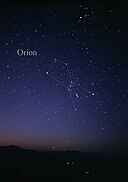In modern astronomy, a constellation is a specific area of the celestial sphere as defined by the International Astronomical Union (IAU). These areas mostly had their origins in Western-traditional asterisms from which the constellations take their names. There are 88 officially recognized constellations, covering the entire sky.

Thus, any given point in a celestial coordinate system can unambiguously be assigned to a constellation. It is usual in astronomy to give the constellation in which a given object is found along with its coordinates in order to convey a rough idea in which part of the sky it is located.
The origin of the word constellation seems to come from the Late Latin term "cōnstellātiō," which can be translated as "set of stars", but came into use in English during the 14th century. A more modern astronomical sense of the term is as a recognisable pattern of stars whose appearance is identified with mythological characters or creatures, or associated earthbound animals or objects.
Colloquial usage does not draw a sharp distinction between "constellation" in the sense of an asterism (pattern of stars) and "constellation" in the sense of an area surrounding an asterism. The modern system of constellations used in astronomy employs the latter concept. For example, the northern asterism known as the Big Dipper comprises the seven brightest stars in the IAU constellation (area) Ursa Major while the southern False Cross includes portions of the constellations Carina and Vela.
The term circumpolar constellation is used for any constellation that, from a particular latitude on Earth, never sets below the horizon. From the North Pole or South Pole, all constellations north or south of the celestial equator are circumpolar constellations. In the equatorial or temperate latitudes, the informal term equatorial constellation has sometimes been used for constellations that lie to the opposite the circumpolar constellations.Depending on the definition, equatorial constellations can include those that lie entirely between declinations 45° north and 45° south, or those that pass overhead between the tropics of Cancer and Capricorn between declinations of 23½° north and 23½° south.They generally include all constellations that intersect the celestial equator or part of the zodiac.
Usually the only thing the stars in a constellation have in common is that they appear near each other in the sky when viewed from the Earth, but in galactic space, most constellation stars lie at a variety of distances. Since stars also travel on their own orbits through the Milky Way, the star patterns of the constellations change slowly over time. After tens to hundreds of thousands of years, their familiar outlines will become unrecognisable.
No comments:
Post a Comment